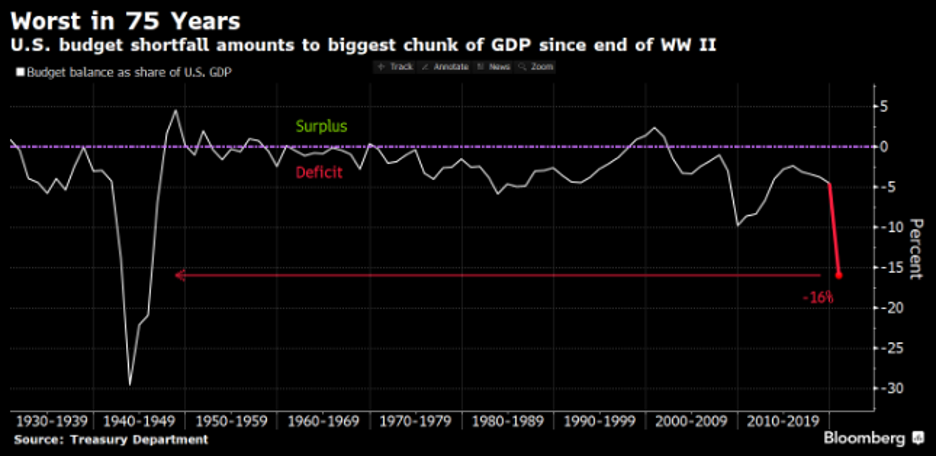Stocks moved mostly sideways this week, as COVID-19 continues to spread globally and fiscal stimulus drama continued. Economic data was mixed this week, with retail sales and consumer sentiment data beating expectations but also producing higher than expected unemployment. Unemployment claims have been choppy but moving downwards, likely indicating slowly recovering labor markets. Recently, unemployment declines have slowed, prompting questions as to whether or not the recovery is coming to a halt. The persistently high case rates of COVID-19 in the U.S. remains concerning, and possibly may be trending upwards. This increase in cases is likely related to schools reopening and may continue for several more weeks. Negotiations toward a second stimulus package remain mired in partisan squabbling. It is now almost certain that a stimulus package will not be passed this year, potentially risking the economic recovery.
Overseas, developed markets fell while emerging markets rose slightly. European indices returned negative results for the week, with Japanese equities following suit. Increasing COVID-19 infections in Europe are becoming increasingly concerning, helping put downward pressure on equities overseas.
Markets were complacent this week, with equity indices bringing in negligible returns. Fears concerning global stability and health are an unexpected factor in asset values, and the recent volatility serves as a great reminder of why it is so important to remain committed to a long-term plan and maintain a well-diversified portfolio. When stocks were struggling to gain traction last month, other asset classes such as gold, REITs, and US Treasury bonds proved to be more stable. flashy news headlines can make it tempting to make knee-jerk decisions, but sticking to a strategy and maintaining a portfolio consistent with your goals and risk tolerance can lead to smoother returns and a better probability for long-term success.
Chart of the Week

Suppressed GDP and massive stimulus packages have pushed the federal budget deficit to levels not seen since 1945. The levels of debt will need to be addressed at some point, as current trajectories are not sustainable.
Market Update
Equities
Broad market equity indices finished the week little changed, with major large cap indices outperforming small cap. Economic data has progressed, but the global recovery still has a long way to go to regain lost jobs and output.
S&P sectors returned mixed results this week. Industrials and communications outperformed, returning 1.10% and 0.90% respectively. Energy and real estate underperformed, posting -2.10% and -2.31% respectively. Technology leads the pack so far YTD, returning 32.23% in 2020.


Commodities
Commodities rose slightly this week, driven by rising energy prices. Energy markets have been highly volatile, with oil investors focusing on output and consumption concerns. Demand is still likely to recover slowly however, as economic activity is not likely to recover instantly from the pandemic. On the supply side, operating oil rigs are still well under early 2020 numbers.
Gold fell this week as the precious metal lost value as the US dollar strengthened. Gold is a common “safe haven” asset, typically rising during times of market stress. Focus for gold has shifted to global macroeconomics and recovery efforts.
Bonds
Yields on 10-year Treasuries fell this week from 0.77% to 0.75% while traditional bond indices rose. Treasury yield movements reflect general risk outlook, and tend to track overall investor sentiment. Treasury yields will continue to be a focus as analysts watch for signs of changing market conditions.
High-yield bonds rose negligibly this week, causing spreads to loosen. High-yield bonds are likely to remain volatile in the short to intermediate term as the Fed has adopted a remarkably accommodative monetary stance and investors flee economic risk factors, likely driving increased volatility.

Lesson to Be Learned
“If investing is entertaining, if you’re having fun, you’re probably not making any money. Good investing is boring.”
-George Soros
We have two simple indicators we share that help you see how the economy is doing (we call this the Recession Probability Index, or RPI), as well as if the US Stock Market is strong (bull) or weak (bear).
In a nutshell, we want the RPI to be low on a scale of 1 to 100. For the US Equity Bull/Bear indicator, we want it to read at least 66.67% bullish. When those two things occur, our research shows market performance is typically stronger, with less volatility.
The Recession Probability Index (RPI) has a current reading of 36.71, forecasting a lower potential for an economic contraction (warning of recession risk). The Bull/Bear indicator is currently 100% bullish, meaning the indicator shows there is a slightly higher than average likelihood of stock market increases in the near term (within the next 18 months).

It can be easy to become distracted from our long-term goals and chase returns when markets are volatile and uncertain. It is because of the allure of these distractions that having a plan and remaining disciplined is mission critical for long term success. Focusing on the long-run can help minimize the negative impact emotions can have on your portfolio and increase your chances for success over time.
The Week Ahead
This week will see updated PMI numbers as well as fresh unemployment claims. As the U.S. presidential election nears, markets are likely to become increasingly focused on its outcome over other factors.
More to come soon. Stay tuned.



